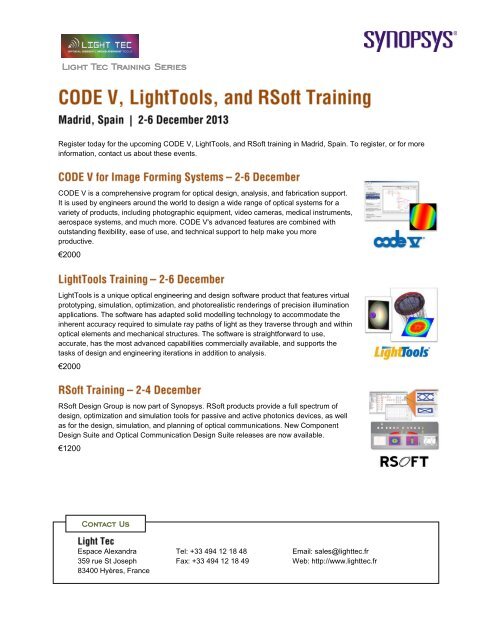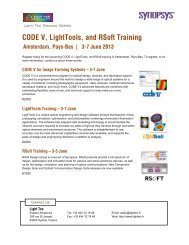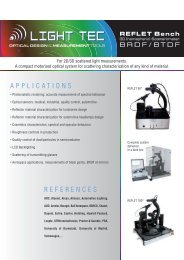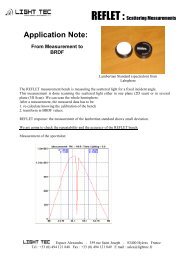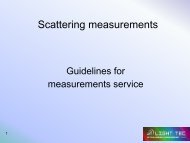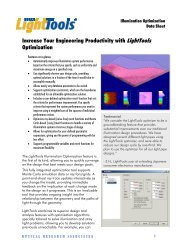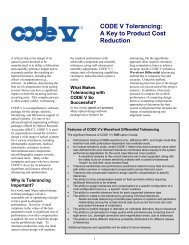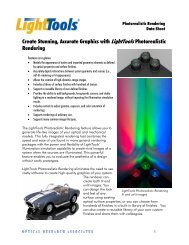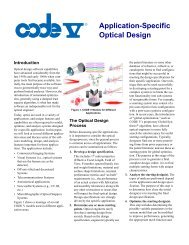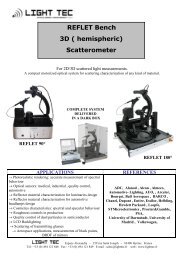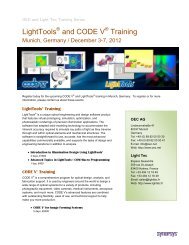download the program - Light Tec
download the program - Light Tec
download the program - Light Tec
Create successful ePaper yourself
Turn your PDF publications into a flip-book with our unique Google optimized e-Paper software.
<strong>Light</strong> <strong>Tec</strong> Training Series<br />
Register today for <strong>the</strong> upcoming CODE V, <strong>Light</strong>Tools, and RSoft training in Madrid, Spain. To register, or for more<br />
information, contact us about <strong>the</strong>se events.<br />
CODE V is a comprehensive <strong>program</strong> for optical design, analysis, and fabrication support.<br />
It is used by engineers around <strong>the</strong> world to design a wide range of optical systems for a<br />
variety of products, including photographic equipment, video cameras, medical instruments,<br />
aerospace systems, and much more. CODE V's advanced features are combined with<br />
outstanding flexibility, ease of use, and technical support to help make you more<br />
productive.<br />
€2000<br />
<strong>Light</strong>Tools is a unique optical engineering and design software product that features virtual<br />
prototyping, simulation, optimization, and photorealistic renderings of precision illumination<br />
applications. The software has adapted solid modelling technology to accommodate <strong>the</strong><br />
inherent accuracy required to simulate ray paths of light as <strong>the</strong>y traverse through and within<br />
optical elements and mechanical structures. The software is straightforward to use,<br />
accurate, has <strong>the</strong> most advanced capabilities commercially available, and supports <strong>the</strong><br />
tasks of design and engineering iterations in addition to analysis.<br />
€2000<br />
RSoft Design Group is now part of Synopsys. RSoft products provide a full spectrum of<br />
design, optimization and simulation tools for passive and active photonics devices, as well<br />
as for <strong>the</strong> design, simulation, and planning of optical communications. New Component<br />
Design Suite and Optical Communication Design Suite releases are now available.<br />
€1200<br />
Contact Us<br />
Espace Alexandra Tel: +33 494 12 18 48 Email: sales@lighttec.fr<br />
359 rue St Joseph Fax: +33 494 12 18 49 Web: http://www.lighttec.fr<br />
83400 Hyères, France
COURSE OVERVIEW<br />
This 4-day short course is a practical introduction to <strong>Light</strong>Tools for engineers<br />
and scientists who wish to model and analyze <strong>the</strong> interaction of light with optomechanical<br />
systems. It assumes some familiarity with optical concepts and<br />
terminology. The course will be taught using <strong>the</strong> latest version of <strong>Light</strong>Tools.<br />
The course is based on interactive examples of various illumination systems<br />
ra<strong>the</strong>r than lectures. This hands-on approach maximizes time spent using<br />
<strong>Light</strong>Tools while incorporating key illumination concepts in <strong>the</strong>ir practical<br />
context. Workshop problems provide opportunity for additional practice. The<br />
course will include how to:<br />
<br />
<br />
<br />
<br />
<br />
<br />
<br />
Create an opto-mechanical system model within <strong>Light</strong>Tools, with<br />
native geometry or imported from a CAD <strong>program</strong><br />
Use Surface Properties to define <strong>the</strong> interaction of light with specular, scattering, or absorbing surfaces<br />
Use Boolean operations to construct complex structures<br />
Set up an illumination system, including multiple sources and multiple receivers<br />
Understand, interpret, and manipulate <strong>the</strong> intensity and illuminance analyses<br />
Create photorealistic renderings of models to visualize <strong>the</strong> system performance<br />
Improve system performance by using <strong>Light</strong>Tools optimization with its various merit functions<br />
COURSE OVERVIEW<br />
This one-day course provides a practical overview of <strong>Light</strong>Tools COM Macro Programming. The course includes<br />
lectures, demonstrations, and hands-on computer workshop sessions. Familiarity with <strong>Light</strong>Tools basic features is<br />
assumed.<br />
The COM Macro Programming capability allows users to automate tasks within <strong>Light</strong>Tools. The course will use Excel<br />
Visual Basic for Applications (VBA) to control <strong>Light</strong>Tools. Basic <strong>program</strong>ming experience is helpful, although<br />
proficiency in VBA is not necessary.<br />
Topics covered in <strong>the</strong> course will include:<br />
COM Macro Programming<br />
Accessing <strong>Light</strong>Tools via Excel’s VBA COM interface<br />
<strong>Light</strong>Tools JumpStart Macro Library<br />
Direct database access
GOALS FOR THIS COURSE<br />
This course for current CODE V users will give you a more detailed understanding of <strong>the</strong> usage and operation of <strong>the</strong><br />
<strong>program</strong>'s more familiar features, and exposure to some of more specialized features as well. You will learn how to<br />
address your design and analysis tasks more effectively and discover new applications for CODE V in your work.<br />
FORMAT FOR THE COURSE<br />
Seminar attendees will be CODE V users with varying interests and experience levels. Thus, a flexible, informal, and<br />
wide-ranging format will be used, which will include presentations on <strong>the</strong> selected topics, computer demonstrations,<br />
hands-on exercises, and informal discussions.<br />
COURSE OUTLINE<br />
Topics will be selected from among <strong>the</strong> following list, with <strong>the</strong> intent being to tailor <strong>the</strong> course content to <strong>the</strong> needs of<br />
<strong>the</strong> attendees. Please let us know, preferably in advance, if you have a particularly strong interest in any of <strong>the</strong> listed<br />
topics.<br />
<br />
<br />
<br />
<br />
<br />
<br />
<br />
<br />
<br />
<br />
<br />
<br />
<br />
<br />
<br />
Background for running CODE V<br />
Performance evaluation<br />
Optimization of lens performance<br />
Reflective optical systems<br />
Non-spherical surfaces<br />
Afocal systems<br />
Zoom and multi-configuration systems<br />
Tolerancing an optical system<br />
Diffraction analysis (including Image Simulation)<br />
Environmental analysis of optical systems<br />
Diffractive and binary optics<br />
Interferograms and <strong>the</strong> Alignment option<br />
Non-sequential surfaces<br />
Macro-PLUS <strong>program</strong>ming<br />
Beam Propagation
GOALS FOR THIS COURSE<br />
This training <strong>program</strong> begins with <strong>the</strong> basics of <strong>the</strong> RSoft System Tools and<br />
gradually moves to intermediate and advanced topics. Here’s a summary of<br />
topics that will be covered:<br />
<br />
<br />
<br />
<br />
<br />
<br />
<br />
<br />
<br />
Introduction to <strong>the</strong> GUI: Creating and editing new project files,<br />
overview of functions and settings, customization options<br />
Introduction to Simulation Engines<br />
Setting up global simulation parameters and consequence on<br />
simulation bandwidth, number of transmitted bits, simulation<br />
accuracy and speed.<br />
Designing a Transmitter: Identifying basic blocks and understanding<br />
<strong>the</strong> role of parameters on transmitter performance<br />
Creating compound components<br />
Setting up a transmission link:<br />
o<br />
o<br />
o<br />
Operation of a single-mode fiber (also multimode fiber on <strong>the</strong> 3rd day of training), fiber impairments<br />
including dispersion, polarization mode dispersion, nonlinear effects (SPM, XPM, FWM), stimulated<br />
Brillouin scattering (SBS), etc.<br />
Overview of optical amplifiers<br />
Dispersion compensation <strong>Tec</strong>hniques in optical domain.<br />
Designing a receiver: PIN and APD, Trans-impedance amplifier, filter, etc.<br />
Performance estimation: Q, BER, Monte Carlo, Inter-symbol interference (ISI), optical/electrical noise<br />
dominant system, Karhunen-Loeve estimation, error counting.<br />
Analysis, visualization and data post-processing options<br />
Including discussions and examples on single-channel and WDM legacy IM/DD (intensity modulation/direct<br />
detection) and coherent communications, 40GB, 100GB and beyond, free space optics, etc<br />
TRAINING METHODOLOGY<br />
The first two days cover OptSim and <strong>the</strong> last day covers ModeSYS. The training is combination of presentation<br />
slides, discussions and hands-on modeling experience with <strong>the</strong> actual products. The applications discussed vary in<br />
complexities and encompass a number of areas within optical communication.
<strong>Light</strong> <strong>Tec</strong> Training Series<br />
WHO SHOULD ATTEND?<br />
Current users of CODE V, <strong>Light</strong>Tools, and RSoft products are invited to attend <strong>the</strong>se training sessions. While <strong>the</strong>re<br />
are no specific prerequisites, some familiarity with optical or illumination design concepts and with <strong>the</strong> software is<br />
helpful, particularly for <strong>the</strong> advanced sections.<br />
Training sessions are subject to space limitations and topics are subject to change without prior notification.<br />
IMPORTANT:<br />
Attendees are responsible for <strong>the</strong>ir own arrangements for accommodation.<br />
Tuition includes all teaching materials.<br />
Tuition must be paid in full prior to attendance. Minimum enrollments apply.<br />
Contact Us<br />
Espace Alexandra Tel: +33 494 12 18 48 Email: sales@lighttec.fr<br />
359 rue St Joseph Fax: +33 494 12 18 49 Web: http://www.lighttec.fr<br />
83400 Hyères, France


